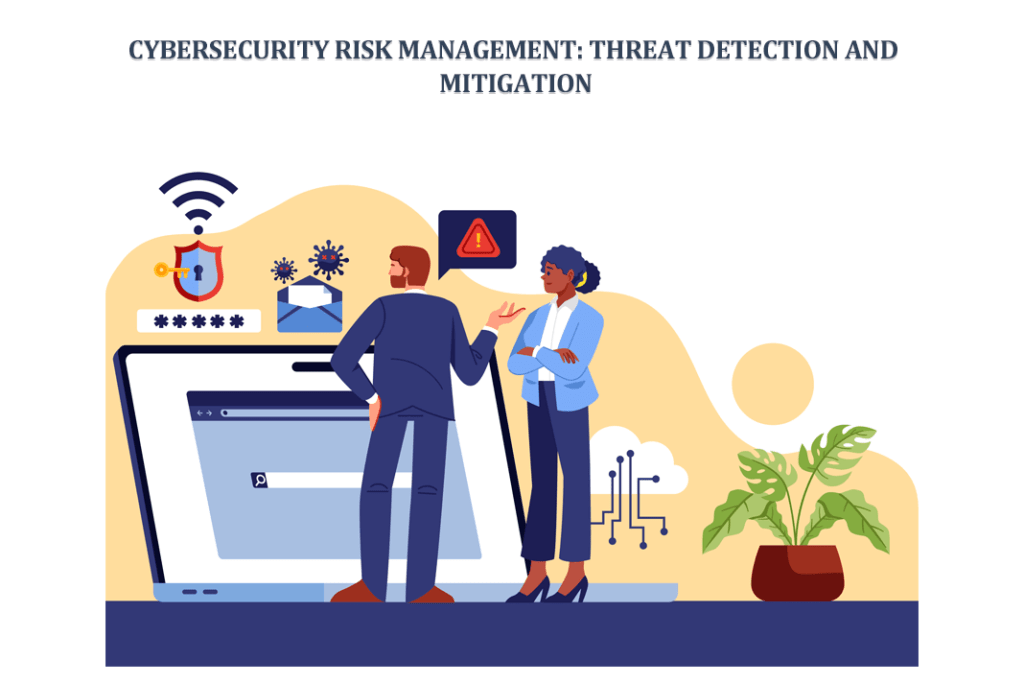How effectively can you respond to the next cyber threat? What do you consider the level of security of your data? As the world increasingly goes digital, there are new problems in cyberspace which need to be managed.
Everyone is vulnerable; even small businesses and large corporations face these challenges. These days, it has become imperative for companies to identify potential risks and respond to them actively as unprecedented threats are more commonplace than ever.
What businesses need is not just protective information; focusing on those risks is critical not just to defend information, but also to uphold operational trust and resilience. This article attempts to outline and describe the basic principles of risk management in cybersecurity, threat detection, and mitigation.
Common Cybersecurity Threats
There are numerous cyber threats to contend with, but the ones listed below are the most prevalent:
- Phishing: These are emails or messages crafted with the intent to deceive individuals into surrendering their passwords or bank details.
- Ransomware: Cybercriminals encrypt files and demand ransom, extorting money for restoration.
- Malware: This is software that either damages computers and data or damages and steals data.
- DDoS Attacks: Shutting down a server by overwhelming it with excessive traffic.
- Insider Threats: Employees or Associates abusing privileges bestowed upon them for personal benefits.
All of the threats explained above may result in dire consequences for the firm. Therefore, being prepared is paramount.
Why Threat Detection Matters
Threat detection refers to identifying potential security concerns well before they become significant issues. In essence, detection requires estimating the potential harm a step forward can create if caught in the end. The longer it takes to uncover potential within systems, the more space left open could compromise databases and finance and render systems useless.
Advanced technology deploys detection features such as:
- Detection Tools (IDS): These are the tools that scan the networks for any suspicious movement of files and users and report in real-time for onward alerting purposes.
- Security Information and Event Management (SIEM): They gather and examine network-wide data.
- Endpoint Detection and Response (EDR): Concentrates on laptops and mobile phones as endpoints, seeking for possible threats.
AI, along with machine learning, improves threat detection accuracy and response. Such technologies study patterns, identify suspicious activities and even take preventive measures to avert attacks before they happen.
Effective Threat Mitigation Strategies
Detections are followed by mitigation, which refers to the process of lessening or entirely neutralizing the detrimental impact of a given threat. Some main mitigation strategies involve the following:
- Firewalls and Antivirus Software: The baseline protectors.
- Regular Software Updates: Eliminate identified software bugs and security loopholes.
- Access Control: Restrict viewing and editing privileges to sensitive data.
- Data Backup: Store important files to safeguard them from being lost or attacked.
- Incident Response Plan: Precise instructions detailing every action to be taken during an attack.
Mitigation involves training employees. Workers need to understand deceptive tactics and practice safe internet browsing.
Building a Cybersecurity Risk Management Plan
A well-structured plan is formed through multiple frameworks:
- Enumerating Assets and Risks: Understand which data, devices, and systems require safeguarding.
- Assess Vulnerabilities: Identify the security gaps in the existing setup.
- Analyze Impact: Identify the potential impacts of various threats on the business.
- Select Preventive Measures: Determine the necessary tools and policies to secure the system and prevent attacks.
- Monitoring and Reviewing: Conduct regular checks of the system and revise the strategy according to the need.
Making cybersecurity an integral part of daily processes is the best way to reduce risk.
Role of Technology in Cybersecurity
Many cybersecurity defenses rely on technology to stop and detect breaches of security or unauthorized information usage. Antivirus programs, data encryption, secure networks, and other technologies physically guard data against unwarranted access. Due to the automation of business processes, businesses require rapid response capabilities, especially during massive attacks.
With the advent of cloud computing and remote work, advanced cybersecurity measures are more needed. Secure cloud services, virtual private networks (VPNs), and multi-factor authentication are now required. Businesses employing functionalities such as WooCommerce variable pricing for online companies need to protect customer payment data and ensure the regular update of plugins to obliterate potential security holes.
Cybersecurity in E-commerce
E-commerce websites constitute a blue ocean for hackers. Customer data is stored and processed for payments, and continuous web access is essential. One breach can tarnish a reputation, resulting in reduced sales. Therefore, these businesses must implement secure payment gateways and SSL certificates and perform frequent malware checks.
Security plugins on systems such as WooCommerce assist in tracking activity on the site and blocking threats. Business owners who issue their own manual recurring/backend payments can also configure recurring payment meetings with customers, which will save them time. They can also issue manual invoices through the system for upfront payments.
Compliance and Legal Requirements
Non-compliance with the set rules can result in significant impacts and lead to business trouble. Thus, Ensure compliance with:
- General Data Protection Regulation – for general EU data movement and businesses physically Available in the EU handling customer data
- HIPAA – adopted by the health care providers in the U.S.
- PCI DSS – all businesses involved with credit card payment information.
Non-government and Business Organizations need to keep up with these points and undergo secure data storage systems. That goes with having an information retention policy and employee training.
Human Factor in Cybersecurity
Technology alone isn’t enough. Human error is a leading cause of data breaches. Clicking a bad link, using a weak password, or sharing information can open the door to hackers.
To lower this risk, businesses should:
- Train Employees Regularly: Teach them how to spot scams.
- Promote Strong Password Habits: Use password managers if needed.
- Encourage Reporting: Make it easy for staff to report suspicious activity.
Creating a culture of security is just as important as using the right tools.
Conclusion
Cybersecurity is imperative in today’s world. Businesses of any size can suffer severe damage from cyber risks. Furthermore, threat detection and mitigation should be a part of a sound risk management framework. Employing the right tools, training personnel, and keeping up with technological advancements helps minimize risks and ensures faster recovery if an attack occurs. As with all things that deal with sensitive information, protecting personal data and safeguarding sales within platforms such as WooCommerce Variable Pricing is paramount. Begin now to construct a foundational strategy that enhances business safety and protects against future threats.
Read More:
FCSO WordPress: Sureshot Ways for Website Success
Become a Digital Signature Certificate Partner | Franchise | Agent



